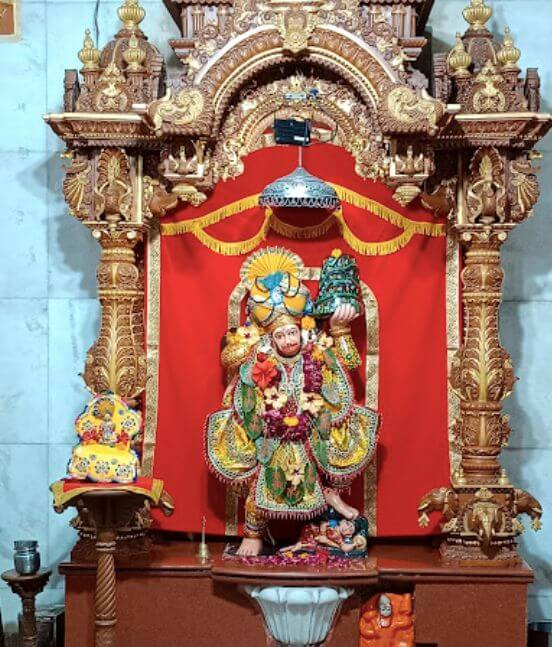 Near the world-famous tourist destination of Adalaj Ni Vav (a renowned stepwell known for its architectural beauty) in the village of Adalaj, lies the Prabha Hanuman Temple. According to religious history, the idol here is about 150 years old. The temple was renovated 25 years ago, resulting in the construction of a grand temple. Devotees believe that Prabha Hanuman is a deity who fulfills wishes, especially for those seeking visas to the United States, which is why many people visit the temple to seek blessings for visa-related matters.
Near the world-famous tourist destination of Adalaj Ni Vav (a renowned stepwell known for its architectural beauty) in the village of Adalaj, lies the Prabha Hanuman Temple. According to religious history, the idol here is about 150 years old. The temple was renovated 25 years ago, resulting in the construction of a grand temple. Devotees believe that Prabha Hanuman is a deity who fulfills wishes, especially for those seeking visas to the United States, which is why many people visit the temple to seek blessings for visa-related matters.
The temple has an interesting historical background. The ancient Hanuman idol was originally enshrined in a small shrine within a dairy in the village of Adalaj. Twenty-five years ago, Ayodhyaprasad Maharaj of the Swaminarayan sect renovated the temple and built the grand structure that stands today. The Swaminarayan sect, a part of the Vaishnav tradition in Gujarat, was founded by Sahajanand Swami, born in 1781 in Uttar Pradesh. Ayodhyaprasad Maharaj, a nephew of Sahajanand Swami, oversaw the construction of many temples under the Swaminarayan order. The first temple built by this sect was the Swaminarayan Temple in Kalupur, Ahmedabad, on land donated by a British officer named Sir Dunlop.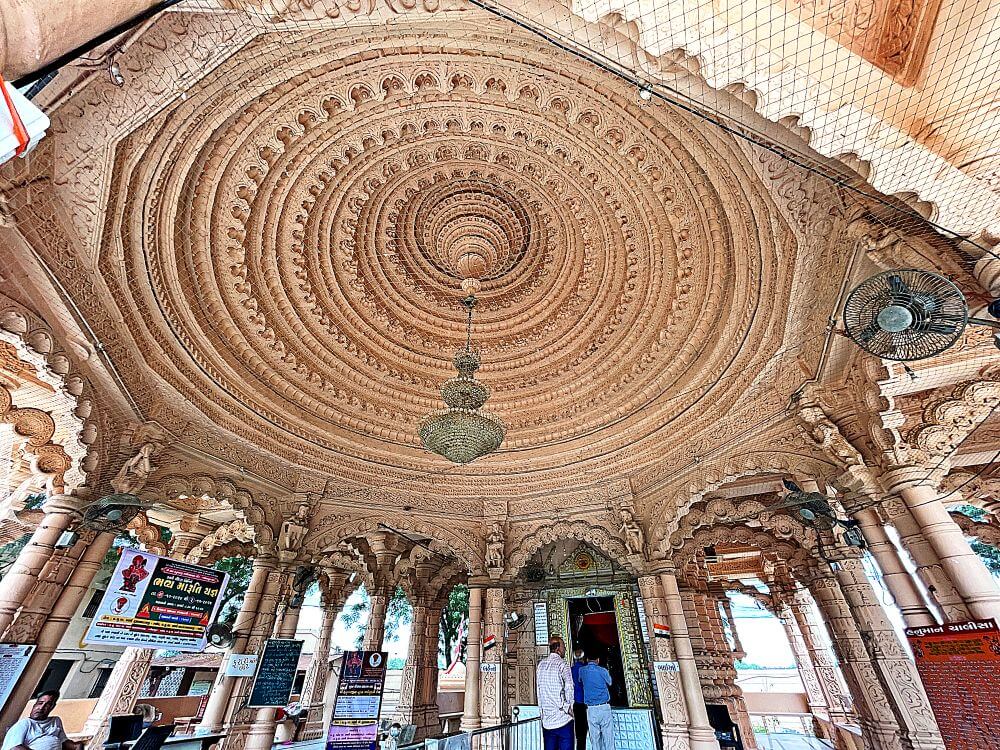 Ayodhyaprasad Maharaj served as the first acharya (spiritual leader) of the temple, and during his tenure, he established several temples, including the Prabha Hanuman Temple in Jamiyatpura, Adalaj.
Ayodhyaprasad Maharaj served as the first acharya (spiritual leader) of the temple, and during his tenure, he established several temples, including the Prabha Hanuman Temple in Jamiyatpura, Adalaj.
The Prabha Hanuman Temple is situated on a three-acre plot near the Ahmedabad-Palampur highway in Jamiyatpura, Adalaj. The temple complex is enclosed by a small boundary wall. The entrance gate is grand, with domes and spires in the traditional Rajasthani style. The temple, built on an elevated platform of pink sandstone, follows the Nagara architectural style, with intricate carvings on the base. The structure consists of the mukhamandapa (entrance hall), sabhamandapa (main hall), and garbhagriha (sanctum sanctorum). 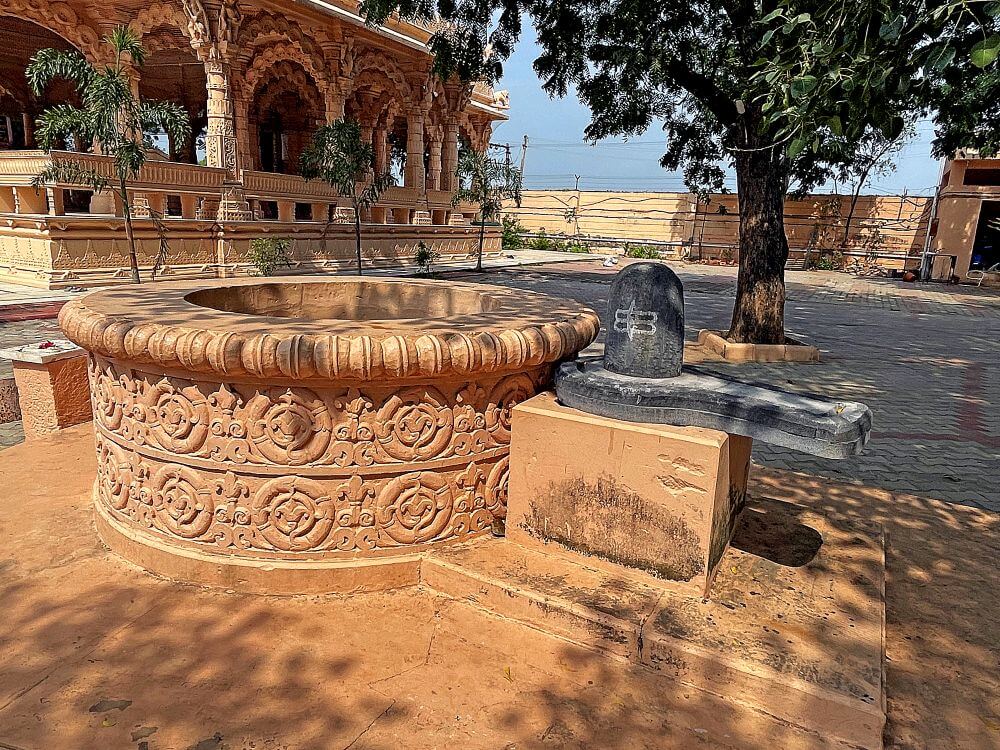 The domes of both the mukhamandapa and sabhamandapa are round and flat-topped, crowned with amalaka (circular stone at the dome’s top) and tall spires (shikhara). The temple’s sanctum sanctorum has a distinctive upward-curving spire, with a red flag flying at the top.
The domes of both the mukhamandapa and sabhamandapa are round and flat-topped, crowned with amalaka (circular stone at the dome’s top) and tall spires (shikhara). The temple’s sanctum sanctorum has a distinctive upward-curving spire, with a red flag flying at the top.
Six steps on either side of the entrance lead up to the mukhamandapa, flanked by statues of elephants carrying ceremonial howdahs (ambaris). Four circular pillars in the mukhamandapa are intricately carved and connected by ornate arches (makar toranas). On the pillars are carvings of gatekeepers (pratihari). Both the mukhamandapa and sabhamandapa are open halls. The pillars inside are adorned with delicate carvings, including representations of deities and celestial maidens (surasundari). Additionally, the inner pillars feature carvings of monkeys. 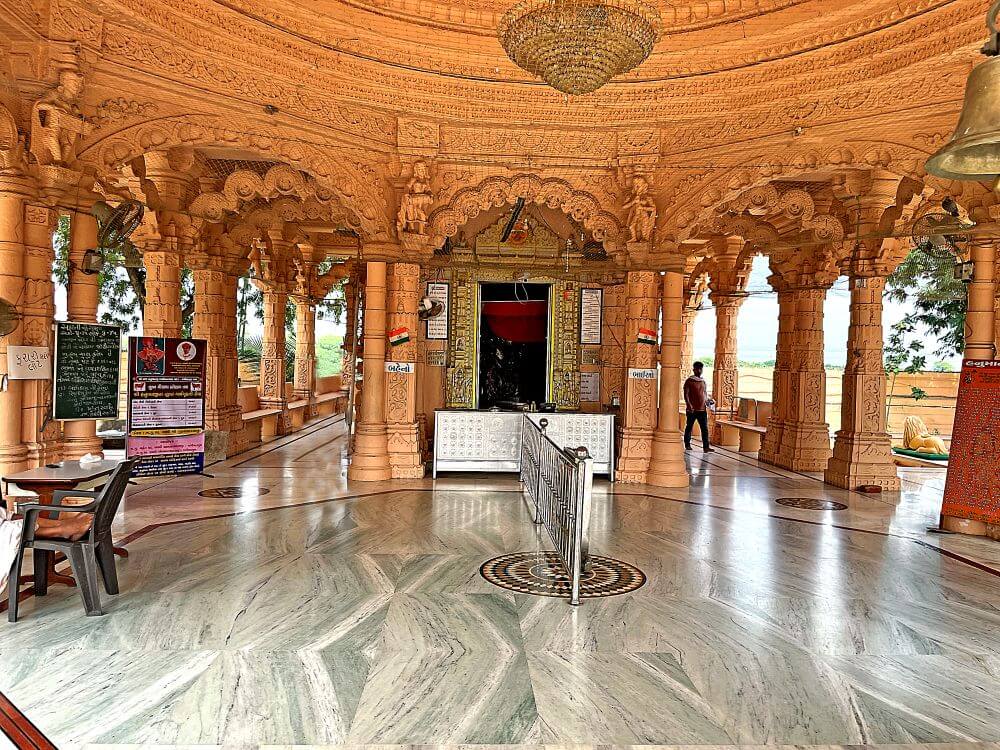 Resting seats are provided in the sabhamandapa for devotees. The sanctum entrance is gilded with golden leaf and features carved images of deities. Above the threshold (mandaraka), there is a carved image of a mythological lion (vyala), while the half-moon-shaped panel above also features intricate carvings.
Resting seats are provided in the sabhamandapa for devotees. The sanctum entrance is gilded with golden leaf and features carved images of deities. Above the threshold (mandaraka), there is a carved image of a mythological lion (vyala), while the half-moon-shaped panel above also features intricate carvings.
Inside the sanctum, Hanuman’s idol is depicted lifting Mount Dronagiri in one hand, and the unique feature of this idol is that Hanuman has a moustache. Below this main idol is a smaller idol covered in vermilion (shendur). The sanctum also has a circumambulatory (pradakshina) path for devotees. The outer walls of the sanctum are adorned with intricate carvings, adding to the beauty of the temple.
Outside the temple stands a well shaped like a Shivalinga, constructed of red stone with circular carvings around its parapet. 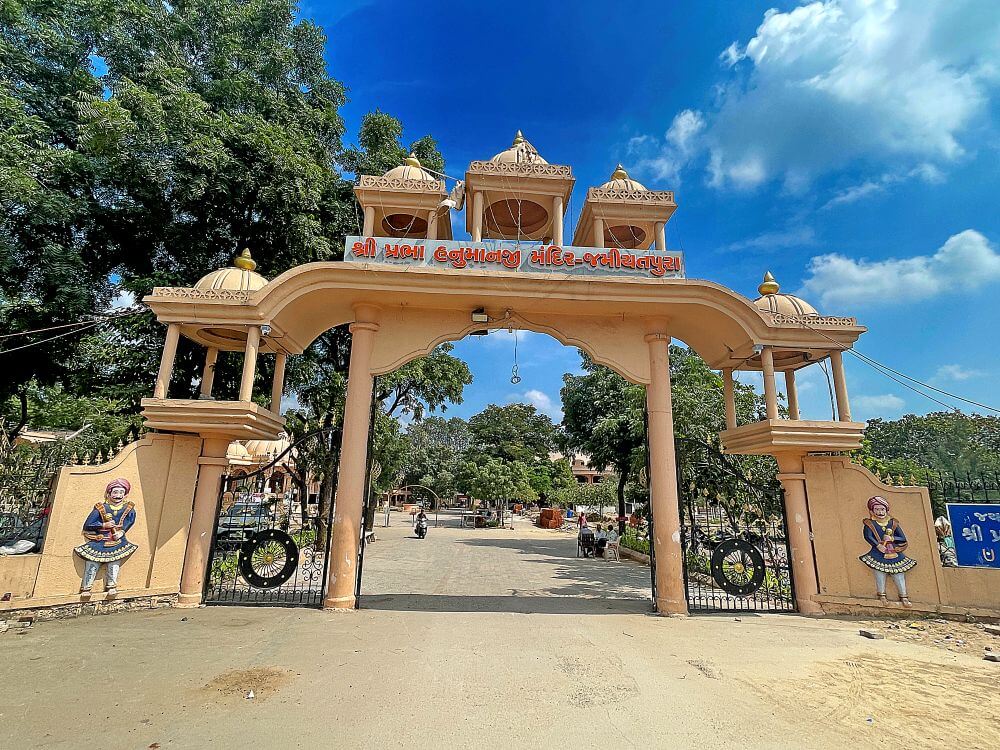 On a raised platform next to the well is a Shivalinga, with the footprints (paduka) of Swaminarayan nearby. It is said that Swaminarayan himself used to drink water from this well. A plaque near the well reads, ‘Bhagwan Sri Swaminarayane kui manthi ghanivara jalapana karela Tevi mahaprasadi ni a kui che.’ (This well is the sacred well from which Bhagwan Shri Swaminarayan used to drink water often.) The temple complex also includes a Swaminarayan temple and a cowshed (goshala).
On a raised platform next to the well is a Shivalinga, with the footprints (paduka) of Swaminarayan nearby. It is said that Swaminarayan himself used to drink water from this well. A plaque near the well reads, ‘Bhagwan Sri Swaminarayane kui manthi ghanivara jalapana karela Tevi mahaprasadi ni a kui che.’ (This well is the sacred well from which Bhagwan Shri Swaminarayan used to drink water often.) The temple complex also includes a Swaminarayan temple and a cowshed (goshala).
Devotees believe that Prabha Hanuman fulfils their desires, especially in matters related to visa applications. Therefore, the temple is crowded, particularly on Tuesdays and Saturdays. Hanuman Jayanti is celebrated with great enthusiasm, with the entire temple complex decorated with flowers and illuminated with lights.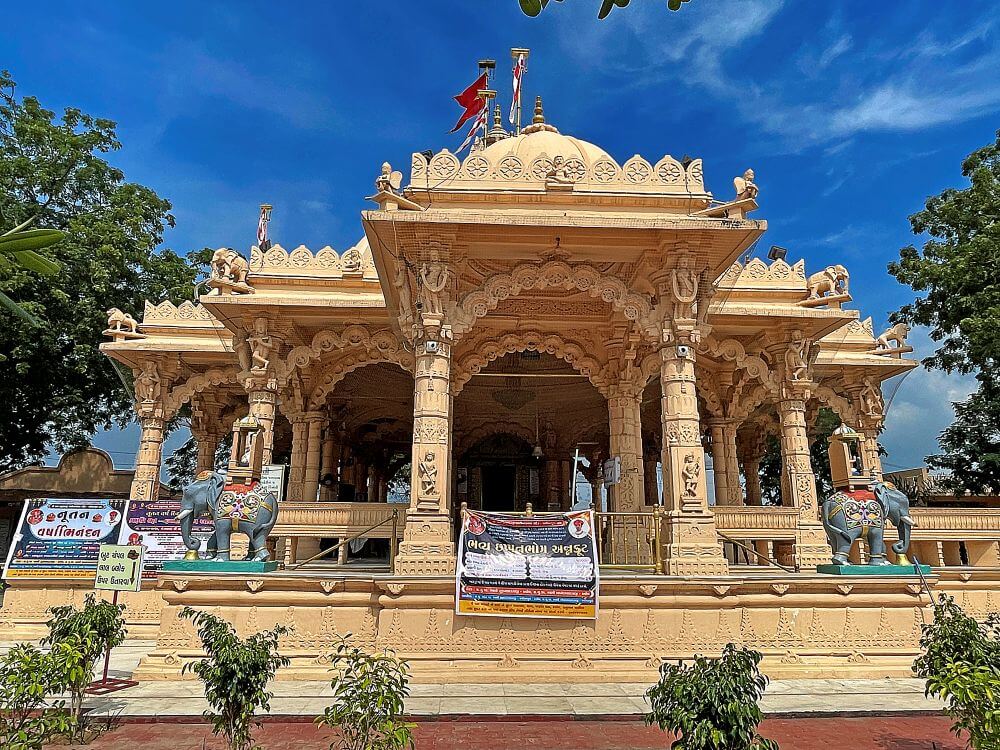 Thousands of devotees participate in this celebration. The temple is open for darshan from 5:30 AM to 12:00 PM and from 3:00 PM to 9:00 PM daily.
Thousands of devotees participate in this celebration. The temple is open for darshan from 5:30 AM to 12:00 PM and from 3:00 PM to 9:00 PM daily.
Approximately 3.5 km from the temple is the world-famous Adalaj Ni Vav, a historic stepwell. Stepwells, known as vavsin Gujarat and baolis in Rajasthan, are intricately carved wells with steps leading down to the water. Due to water scarcity in these regions, such wells were considered highly valuable, and many were artistically constructed. Adalaj Ni Vav is one of the finest examples of Indo-Islamic architecture, built in 1498 by Queen Rudabai, wife of King Rana Veer Singh of the Dandai Desh region. Legend has it that after the king was killed in battle against Sultan Mahmud Begada of Gujarat, Queen Rudabai planned to commit sati (self-immolation). However, the Sultan proposed marriage to her. She agreed on the condition that he complete the stepwell, which the king had started. After the well was completed, the queen, instead of marrying Begada, chose to end her life by jumping into the well.
The Adalaj stepwell is built from pink sandstone and is five storeys deep. The well is octagonal at the top and has three entrances leading down to the water. The entire structure is adorned with intricate carvings, with every pillar, beam, and wall covered in ornate designs. Visitors from all over the world come to see this remarkable architectural wonder. It is also designed in such a way that the temperature inside the well is always 5 to 6 degrees cooler than outside. It is said that the construction of the well cost around five lakh rupees at the time. The stepwell is located about 5 km from Gandhinagar and 18 km from Ahmedabad.
